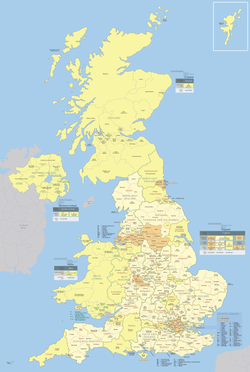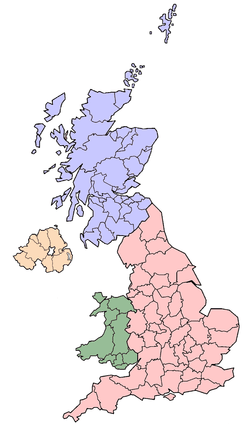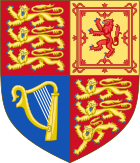Administrative geography of the United Kingdom
The administrative geography of the United Kingdom is complex, multi-layered and non-uniform. The United Kingdom, a sovereign state to the northwest of continental Europe, consists of England, Northern Ireland, Scotland and Wales. For local government in the United Kingdom, England, Northern Ireland, Scotland and Wales each have their own system of administrative and geographic demarcation. Consequently, there is "no common stratum of administrative unit encompassing the United Kingdom".[1]


Because there is no written document that comprehensively encompasses the British constitution, and owing to a convoluted history of the formation of the United Kingdom, a variety of terms are used to refer to its constituent parts, which are sometimes called the four countries of the United Kingdom.[2] The four are sometimes collectively referred to as the Home Nations, particularly in sporting contexts. Although the four countries are important for legal and governmental purposes, they are not comparable to administrative subdivisions of most other countries.
Historically, the subnational divisions of the UK have been the county[3] and the ecclesiastical parish, whilst following the emergence of a unified parliament of the United Kingdom, the ward and constituency have been pan-UK political subdivisions. More contemporary divisions include Lieutenancy areas and the statistical territories defined with the modern NUTS:UK and ISO 3166-2:GB systems.
History

This structure was formed by the union agreed between the former sovereign states, the Kingdom of England (including the Principality of Wales) and the Kingdom of Scotland in the Treaty of Union and enacted by the Acts of Union 1707 to form the single Kingdom of Great Britain (1707–1800); followed by the Act of Union 1800, which combined Great Britain with the Kingdom of Ireland to form the United Kingdom of Great Britain and Ireland. The independence of the Irish Free State in 1922, following the partition of Ireland, resulted in the present-day United Kingdom of Great Britain and Northern Ireland.
Wales was incorporated into the English legal system through the Laws in Wales Acts 1535-1542, the earlier Statute of Rhuddlan having restricted but not abolished Welsh Law following the Edwardian conquest in 1282. As a result, England and Wales are treated as a single entity for some purposes, principally that they share a legal system (see English law), while Scotland and Northern Ireland each have a separate legal system (see Scots Law and Northern Ireland law).[4]
Northern Ireland was the first part of the British Isles to have a devolved government, under the Government of Ireland Act 1920, and that continued until the Parliament of Northern Ireland was suspended in 1972. After a period of direct rule by the Westminster government and some abortive attempts at reinstating devolved government during the Troubles, the present-day Northern Ireland Assembly was established in 1998, and is currently in operation following a number of periods of suspension. The complex history of Northern Ireland has led to differing views as to its status. The term "Province" is often used by unionist and British commentators to refer to Northern Ireland, but not by nationalists.[5]
Overview of administration
| Country | United Kingdom[L] | ||||||||
|---|---|---|---|---|---|---|---|---|---|
| Part of UK | England | Wales[L] | Scotland[L] | Northern Ireland[L] | |||||
| Authority area | Greater London Authority and combined authority areas,[C] other areas | ||||||||
| Lieutenancy area | Ceremonial counties | Preserved counties | Lieutenancy areas | Lieutenancy areas | |||||
| County type | Non-metropolitan | Metropolitan | Unique | ||||||
| County council area | Two-tier council area[C] | Unitary authority areas[C][U] | None | None | City of London[C] | Isles of Scilly[C][S] | Principal areas[C] | Council areas[C] | Districts[C] |
| District | Non-metropolitan districts[B][C] | Metropolitan boroughs[B][C] | London boroughs[C] | ||||||
| Parish | Civil parishes[C][T] | Wards | Civil parishes | Communities[M] | Communities | Civil parishes | |||
- Notes
The markers above link to relevant articles where available.
- [B] Can have city, borough or royal borough status
- [C] Has a council
- [L] Has a legislature
- [M] May have a council
- [S] Sui generis unitary authority. Not a county nor part of Cornwall. Powers similar to a mainland county.
- [T] Can have city, town, village or neighbourhood status. Not all areas of England have parishes.
- [U] County council areas comprising one district. The council is at either county or district level.
Local government
England
England has no devolved national legislature or government.
The highest level subdivisions of England are the nine regions. The London region, known as Greater London, is further divided into the City of London and 32 London boroughs. This is administered by the Greater London Authority, including the directly elected London Assembly. The other regions are made up of metropolitan and non-metropolitan counties and unitary authorities. The counties are further divided into districts (which can be called cities, boroughs, royal boroughs, metropolitan boroughs or districts). The unitary authorities effectively combine the functions of counties and districts.
Below the district level, civil parishes exist, though not uniformly. Parish or town councils exist for villages and small towns; they only rarely exist for communities within urban areas.
Commonly, though not administratively, England's geography is divided into ceremonial counties, which in most areas closely mirror the traditional counties. Each ceremonial county has a Lord Lieutenant, who is the monarch's representative.
Northern Ireland
Northern Ireland has the Northern Ireland Assembly and Northern Ireland Executive established under the Good Friday Agreement. During periods where the devolved institutions were suspended, executive government in Northern Ireland was administered directly by the Secretary of State for Northern Ireland and laws made in the United Kingdom Parliament – known as "direct rule" in contrast to devolution.
For local government, Northern Ireland is divided into 11 districts, which are unitary authorities.
Northern Ireland is divided into six traditional counties. Though widely used, these no longer serve any administrative purpose.
Scotland
Scotland has a devolved legislature, the Scottish Parliament, with a government, known as the Scottish Government since 1999.
For local government, Scotland has 32 council areas (unitary authorities). Below this uniform level of subdivision, there are varying levels of area committees in the larger rural council areas, and many small community councils throughout the country, although these are not universal. Scottish community councils have few if any powers beyond being a forum for raising issues of concern.
Wales
Wales has an elected, devolved legislature, the Senedd Cymru – Welsh Parliament, from which the Welsh Government is drawn. For local government, Wales consists of 22 unitary authorities: 10 county boroughs, 9 Counties, and 3 Cities. Below these are community councils, which have powers similar to those of English parish councils.
Wales is also divided into preserved counties, which are used for ceremonial purposes. Although based on the counties used for local government between 1974 and 1996, they no longer have an administrative function.
Democratic representation
Parliaments
In terms of the Parliament of the United Kingdom, each of the electoral areas or divisions called constituencies elects one Member of Parliament to represent it at the House of Commons of the United Kingdom. Constituencies also exist for the devolved Scottish Parliament, Senedd Cymru – Welsh Parliament and Northern Irish Assembly.
Local government
The wards and electoral divisions of the United Kingdom are electoral districts at subnational level represented by one or more councillors at local authority level, or else used to divide the electorate into electoral districts for voting. It is the primary unit of British electoral geography.
Informal divisions
There are also many informal, historical and special purpose regional designations. Some such as the Highlands of Scotland have or have had, to some extent, formal boundaries. Others such as the London commuter belt are more diffuse. Some such as Snowdonia (Eryri) have a formal boundary in some contexts; in this case as a National Park. Others such as The Fens of eastern England are quite distinctly defined by geography but do not form any official entity.
International subdivisions
Both Eurostat and the International Organization for Standardization have developed subdivision codes for the UK. See NUTS:UK and ISO 3166-2:GB.
Dependent territories
The United Kingdom has 14 British overseas territories scattered around the world. Unlike some former colonial powers, the British Government does not classify its overseas possessions (or the crown dependencies, which share historical ties with the British Crown) as subdivisions of the United Kingdom itself; rather, each is treated in law as a separate jurisdiction. Most have their own legislatures and a degree of autonomy usually exceeding that of the devolved UK nations, including fiscal independence.
However, the UK retains varying degrees of responsibility in all of the territories, currently ranging from full political control to a largely ceremonial presence. The main reserved matters are the areas of diplomacy, international treaties, defence and security. The UK also retains in all territories a residual responsibility for 'good governance', a loosely defined constitutional concept recently exemplified by its imposition of direct rule following alleged serious corruption in the Turks and Caicos Islands. The UK parliament at Westminster, and the British Government through the Privy Council, both retain the power to legislate for the overseas territories – though by convention will usually only do so with each local government's consent.
The three crown dependencies within the British Isles are self-governing[6] possessions of the British Crown. They are distinct from the British overseas territories of the United Kingdom.[7]
See also
- Countries of the United Kingdom
- Devolution in the United Kingdom
- European Parliament constituencies in the United Kingdom
- British Isles (terminology)
- British overseas territories
- Crown dependencies
- Etymological list of counties of the United Kingdom
- List of subnational entities
- Office for National Statistics coding system for counties, districts, wards and census areas
- List of regions of the United Kingdom by Human Development Index
References
- United Nations Economic and Social Council (August 2007). "Ninth United Nations Conference on the standardization of Geographical Names" (PDF). unstats.un.org. Archived from the original (PDF) on 30 October 2008. Retrieved 2008-10-21.
- Scottish Parliament. "Your Scotland questions; Is Scotland a country?". scottish.parliament.uk. Archived from the original on 21 June 2008. Retrieved 2008-08-01.
As the UK has no written constitution in the usual sense, constitutional terminology is fraught with difficulties of interpretation and it is common usage nowadays to describe the four constituent parts of the UK (Scotland, England, Wales and Northern Ireland) as “countries”.
- Bryne, T., Local Government in Britain, (1994)
- Macinnes, Professor Allan I. (17 February 2017). "Acts of Union: The creation of the United Kingdom". BBC. Retrieved 13 November 2019.
- Carmichael, Paul (1 June 2003). "The Northern Ireland Civil Service under Direct Rule and Devolution". International Review of Administrative Sciences. International Review of Administrative Services. 69 (2): 205–217. doi:10.1177/0020852303069002006.
- "Archived copy" (PDF). Archived (PDF) from the original on 2015-10-22. Retrieved 2015-03-09.CS1 maint: archived copy as title (link) Background briefing on the Crown dependencies: Jersey, Guernsey and the Isle of Man
- Commons, The Committee Office, House of. "House of Commons – Crown Dependencies – Justice Committee". publications.parliament.uk. Archived from the original on 23 June 2012. Retrieved 3 May 2018.
.svg.png)
